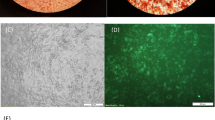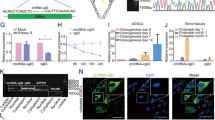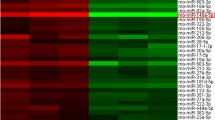Abstract
The repair of skeletal defects is the main goal of bone tissue engineering. Recent literature highlighted various regulatory roles of microRNAs in stem cell fate determination. In addition, the role of porous hydroxyapatite/polycaprolacton (nHA/PCL) as a bioactive scaffold which enhances adipose tissue-derived mesenchymal stem cells (AT-MSCs) growth and osteogenic differentiation has been proved. The aim of the present study was to investigate the synergistic potential of both down-regulating miR-221 and nHA/PCL scaffold seeding in osteogenic potential of AT-MSCs. After isolation and characterization of AT-MSCs, the transfection of anti-miR-221 was performed into the cells using lipofectamine 2000 and the transfected cells were seeded into a synthesized nHA/PCL scaffold. The DAPI staining confirmed the presence of AT-MSCs on nHA/PCL scaffold. Quantitative expression of osteoblast marker genes, Runx2, and osteocalcin of the transfected cells in the scaffold were evaluated. Interestingly, significant upregulation of transcribed Runx2 and osteocalcin genes (P < 0.01) were observed in miR-221-inhibited nHA/PCL seeded cells. Also, alkaline phosphatase activity (ALP) was significantly higher (P < 0.01) in miR-221-inhibited AT-MSCs seeded on nHA/PCL than those seeded on nHA/PCL or transfected with anti-miR-221, individually. The results of this combination suggest a valuable method for enhancing osteogenesis in AT-MSCs. This method could be applicable for gene-cell therapy of bone defects.






Similar content being viewed by others
References
Ahn HH, Kim KS, Lee JH et al (2009) In vivo osteogenic differentiation of human adipose-derived stem cells in an injectable in situ–forming gel scaffold. Tissue Eng A 15:1821–1832
Alizadeh E, Akbarzadeh A, Eslaminejad MB et al. (2014). Up-regulation of liver enriched transcription factors (HNF4a and HNF6) and liver specific microRNA (miR-122) by inhibition of Let-7b in mesenchymal stem cells. Chem biol drug des.
Alizadeh E, Zarghami N, Eslaminejad MB et al. (2014). The effect of dimethyl sulfoxide on hepatic differentiation of mesenchymal stem cells. Artificial Cells, Nanomedicine, Biotechnol 1–8.
Alizadeh E, Eslaminejad MB, Akbarzadeh A et al. (2015). Up-regulation of MiR-122 via trichostatin a treatments in hepatocyte like cells derived from mesenchymal stem cells. Chem Biol Drug Des.
Arnsdorf EJ, Tummala P, Jacobs CR (2009) Non-canonical Wnt signaling and N-cadherin related beta-catenin signaling play a role in mechanically induced osteogenic cell fate. PLoS One 4:e5388
Bakhshandeh B, Hafizi M, Ghaemi N et al (2012a) Down-regulation of miRNA-221 triggers osteogenic differentiation in human stem cells. Biotechnol Lett 34:1579–1587
Bakhshandeh B, Soleimani M, Hafizi M et al (2012b) MicroRNA signature associated with osteogenic lineage commitment. Mol Biol Rep 39:7569–7581
Bartel DP (2004) MicroRNAs: genomics, biogenesis, mechanism, and function. Cell 116:281–297
Bauersachs J, Thum T (2011) Biogenesis and regulation of cardiovascular microRNAs. Circ Res 109:334–347
Bentwich I (2005) Prediction and validation of microRNAs and their targets. FEBS Lett 579:5904–5910
Bruder SP, Fink DJ, Caplan AI (1994) Mesenchymal stem cells in bone development, bone repair, and skeletal regenaration therapy. J Cell Biochem 56:283–294
Cai X, Li G, Wang J et al. (2012) Osteogenesis of adipose-derived stem cells. INTECH Open Access Publisher.
Chastain SR, Kundu AK, Dhar S et al (2006) Adhesion of mesenchymal stem cells to polymer scaffolds occurs via distinct ECM ligands and controls their osteogenic differentiation. J Biomed Mater Res A 78:73–85
Chen L, Jiang W, Huang J et al (2010) Insulin-like growth factor 2 (IGF-2) potentiates BMP-9-induced osteogenic differentiation and bone formation. J Bone Miner Res 25:2447–2459
Damme A, Driessche T, Collen D et al (2002) Bone marrow stromal cells as targets for gene therapy. Curr Gene Ther 2:195–209
D’Antò V, Raucci MG, Guarino V et al. (2013). Behaviour of human mesenchymal stem cells on chemically synthesized HA–PCL scaffolds for hard tissue regeneration. J Tissue Eng Regen Med.
Dong S, Yang B, Guo H et al (2012) MicroRNAs regulate osteogenesis and chondrogenesis. Biochem Biophys Res Commun 418:587–591
Elfick A (2002) Poly (ε-caprolactone) as a potential material for a temporary joint spacer. Biomaterials 23:4463–4467
Friedman RC, Farh KK-H, Burge CB et al (2009) Most mammalian mRNAs are conserved targets of microRNAs. Genome Res 19:92–105
Gómez-Barrena E, Rosset P, Lozano D et al (2015) Bone fracture healing: cell therapy in delayed unions and nonunions. Bone 70:93–101
Guntur AR, Rosen CJ, Naski MC (2012) N-cadherin adherens junctions mediate osteogenesis through PI3K signaling. Bone 50:54–62
Habraken W, Wolke J, Jansen J (2007) Ceramic composites as matrices and scaffolds for drug delivery in tissue engineering. Adv Drug Deliv Rev 59:234–248
Hassan MQ, Gordon JA, Beloti MM et al (2010) A network connecting Runx2, SATB2, and the miR-23a∼27a∼24–2 cluster regulates the osteoblast differentiation program. Proc Natl Acad Sci 107:19879–19884
Hassan MI, Sun, T, Sultana N (2014). Fabrication of nanohydroxyapatite/poly (caprolactone) composite microfibers using electrospinning technique for tissue engineering applications. J Nanomaterials 2014.
Hellmich C, Ulm F-J (2003) Average hydroxyapatite concentration is uniform in the extracollagenous ultrastructure of mineralized tissues: evidence at the 1–10-μm scale. Biomech Model Mechanobiol 2:21–36
Hench LL, Wheeler DL, Greenspan DC (1998) Molecular control of bioactivity in sol–gel glasses. J Sol-Gel Sci Technol 13:245–250
Hu R, Liu W, Li H et al (2011) A Runx2/miR-3960/miR-2861 regulatory feedback loop during mouse osteoblast differentiation. J Biol Chem 286:12328–12339
Inose H, Ochi H, Kimura A et al (2009) A microRNA regulatory mechanism of osteoblast differentiation. Proc Natl Acad Sci 106:20794–20799
Itoh T, Takeda S, Akao Y (2010) MicroRNA-208 modulates BMP-2-stimulated mouse preosteoblast differentiation by directly targeting V-ets erythroblastosis virus E26 oncogene homolog 1. J Biol Chem 285:27745–27752
Javazon EH, Beggs KJ, Flake AW (2004) Mesenchymal stem cells: paradoxes of passaging. Exp Hematol 32:414–425
Kim YJ, Bae SW, Yu SS et al (2009) miR-196a regulates proliferation and osteogenic differentiation in mesenchymal stem cells derived from human adipose tissue. J Bone Miner Res 24:816–825
Koh W, Sheng CT, Tan B et al (2010) Analysis of deep sequencing microRNA expression profile from human embryonic stem cells derived mesenchymal stem cells reveals possible role of let-7 microRNA family in downstream targeting of hepatic nuclear factor 4 alpha. BMCGenomics 11(Suppl 1):S6–S6
Le Blanc K, Pittenger M (2005) Mesenchymal stem cells: progress toward promise. Cytotherapy 7:36–45
Luo J, Tang M, Huang J et al (2010) TGFβ/BMP type I receptors ALK1 and ALK2 are essential for BMP9-induced osteogenic signaling in mesenchymal stem cells. J Biol Chem 285:29588–29598
Ohgushi H, Goldberg VM, Caplan AI (1989) Repair of bone defects with marrow cells and porous ceramic: experiments in rats. Acta Orthop 60:334–339
Osathanon T, Chuenjitkuntaworn B, Nowwarote N et al (2014) The responses of human adipose-derived mesenchymal stem cells on polycaprolactone-based scaffolds: an in vitro study. Tissue Eng Regen Med 11:239–246
Parker A, Shang H, Khurgel M et al (2007) Low serum and serum-free culture of multipotential human adipose stem cells. Cytotherapy 9:637–646
Poinern GE, Brundavanam RK, Mondinos N et al (2009) Synthesis and characterisation of nanohydroxyapatite using an ultrasound assisted method. Ultrason Sonochem 16:469–474
Prante C, Bieback K, Funke C et al (2006) The formation of extracellular matrix during chondrogenic differentiation of mesenchymal stem cells correlates with increased levels of xylosyltransferase I. Stem Cells 24:2252–2261
Reiser J, Zhang X-Y, Hemenway CS. et al. (2005). Potential of mesenchymal stem cells in gene therapy approaches for inherited and acquired diseases.
Schaap-Oziemlak AM, Raymakers RA, Bergevoet SM et al (2009) MicroRNA hsa-miR-135b regulates mineralization in osteogenic differentiation of human unrestricted somatic stem cells. Stem Cells Dev 19:877–885
Schindeler A, Little DG (2006) Ras − MAPK signaling in osteogenic differentiation: friend or foe? J Bone Miner Res 21:1331–1338
Serra T, Planell JA, Navarro M (2013) High-resolution PLA-based composite scaffolds via 3-D printing technology. Acta Biomater 9:5521–5530
Shor L, Güçeri S, Wen X et al (2007) Fabrication of three-dimensional polycaprolactone/hydroxyapatite tissue scaffolds and osteoblast-scaffold interactions in vitro. Biomaterials 28:5291–5297
Undale AH, Westendorf JJ, Yaszemski MJ et al. (2009). Mesenchymal stem cells for bone repair and metabolic bone diseases. Paper presented at Mayo Clinic Proceedings (Elsevier).
Vats A, Tolley N, Polak J et al (2002) Stem cells: sources and applications. Clin Otolaryngol Allied Sci 27:227–232
Venugopal J, Prabhakaran MP, Zhang Y et al (2010) Biomimetic hydroxyapatite-containing composite nanofibrous substrates for bone tissue engineering. Philos Trans Royal Soc London A: Math, Phys Eng Sci 368:2065–2081
Wang Y, Liu L, Guo S (2010) Characterization of biodegradable and cytocompatible nano-hydroxyapatite/polycaprolactone porous scaffolds in degradation in vitro. Polym Degrad Stab 95:207–213
Wutticharoenmongkol P, Pavasant P, Supaphol P (2007) Osteoblastic phenotype expression of MC3T3-E1 cultured on electrospun polycaprolactone fiber mats filled with hydroxyapatite nanoparticles. Biomacromolecules 8:2602–2610
Xin X, Hussain M, Mao JJ (2007) Continuing differentiation of human mesenchymal stem cells and induced chondrogenic and osteogenic lineages in electrospun PLGA nanofiber scaffold. Biomaterials 28:316–325
Zuk PA, Zhu M, Ashjian P et al (2002) Human adipose tissue is a source of multipotent stem cells. Mol Biol Cell 13:4279–4295
Acknowledgments
The present work is part of an MSc thesis supported financially (Grant No. 5/104/577) by The Umbilical Cord Stem Cell Research Center (UCSRC), Tabriz University of Medical Sciences, Tabriz, Iran. Also, we thank Tarbiat Modares University for providing technical assistance.
Author information
Authors and Affiliations
Corresponding author
Ethics declarations
Conflict of interest
The authors declare that they have no conflict of interests.
Additional information
Editor: Tetsuji Okamoto
Rights and permissions
About this article
Cite this article
Hoseinzadeh, S., Atashi, A., Soleimani, M. et al. MiR-221-inhibited adipose tissue-derived mesenchymal stem cells bioengineered in a nano-hydroxy apatite scaffold. In Vitro Cell.Dev.Biol.-Animal 52, 479–487 (2016). https://doi.org/10.1007/s11626-015-9992-x
Received:
Accepted:
Published:
Issue Date:
DOI: https://doi.org/10.1007/s11626-015-9992-x




